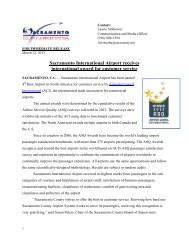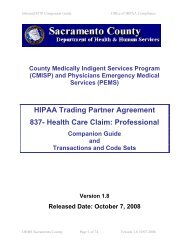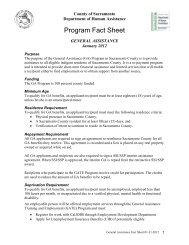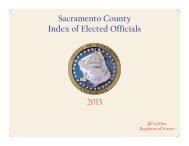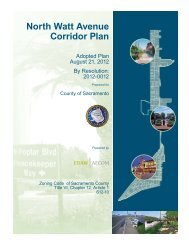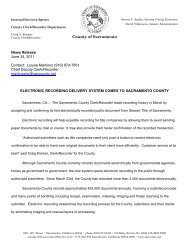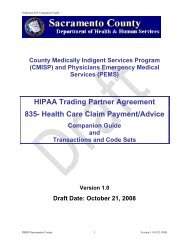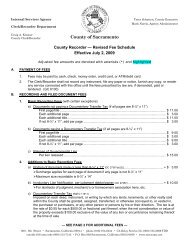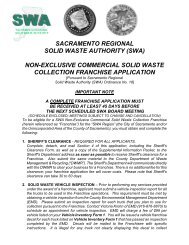Flex Plan Summary - Personnel - Sacramento County
Flex Plan Summary - Personnel - Sacramento County
Flex Plan Summary - Personnel - Sacramento County
You also want an ePaper? Increase the reach of your titles
YUMPU automatically turns print PDFs into web optimized ePapers that Google loves.
Restated: October 2012FLEXIBLE BENEFITS PLANSUMMARY OF BENEFITSDEPENDENT CARE REIMBURSEMENT ACCOUNTMEDICAL REIMBURSEMENT ACCOUNTHEALTH SAVINGS ACCOUNTPREMIUM ONLY
COUNTY OF SACRAMENTOFLEXIBLE BENEFIT PLANTABLE OF CONTENTSPage(s)IntroductionI. How The <strong>Flex</strong>ible Benefit <strong>Plan</strong> Works . . . . . . . . . . . . . . . .1-2II.<strong>Flex</strong>ible Spending AccountMedical Reimbursement Account . . . . . . . . . . . . . . . 3-8Special Rules . . . . . . . . . . . . . . . . . . . . . . . . . . 3-4Eligible Expenses . . . . . . . . . . . . . . . . . . . . . . . 4-6Ineligible Expenses . . . . . . . . . . . . . . . . . . . . . 6-7Enrollment And Making Changes . . . . . . . . . . . 7How To Make A Claim . . . . . . . . . . . . . . . . . . . . 7Participation Termination And COBRA . . . . . . 8Dependent Care Reimbursement Account . . . . . . . 9-12Special Rules . . . . . . . . . . . . . . . . . . . . . . . . . .9-10Eligible Expenses . . . . . . . . . . . . . . . . . . . . . 10-11Ineligible Expenses . . . . . . . . . . . . . . . . . . . . . .11Enrollment And Making Changes . . . . . . . . . . 11How To Make A Claim . . . . . . . . . . . . . . . . . . . .12Participation Termination . . . . . . . . . . . . . . . . .12III. Premium Conversion Option . . . . . . . . . . . . . . . . . . . . . . . .13IV. Health Savings Account . . . . . . . . . . . . . . . . . . . . . . . . . .14-17Special Rules . . . . . . . . . . . . . . . . . . . . . . . . . . . .14Eligible Expenses . . . . . . . . . . . . . . . . . . . . . .14-15Ineligible Expenses . . . . . . . . . . . . . . . . . . . . 15-16How To Make A Claim . . . . . . . . . . . . . . . . . . . . 16Enrollment And Making Changes . . . . . . . . . . . 16Contribution Limits . . . . . . . . . . . . . . . . . . . . 16-17What Happens When You Leave <strong>County</strong>Employment . . . . . . . . . . . . . . . . . . . . . . . . . . 17Taxation Of Distributions . . . . . . . . . . . . . . . . . . . . . . . . . . . 17i
COUNTY OF SACRAMENTOFLEXIBLE BENEFIT PLANTABLE OF CONTENTS (cont.)Page(s)V. Cash Benefit Feature . . . . . . . . . . . . . . . . . . . . . . . . . . .18-19Special Rules . . . . . . . . . . . . . . . . . . . . . . . . . . 18Cash Back From Subsidy . . . . . . . . . . . . . . . . . . 18-19<strong>Plan</strong> Selection Incentive . . . . . . . . . . . . . . . . . . . . 19VI. General Information . . . . . . . . . . . . . . . . . . . . . . . . . . . . . . . 20-24Purpose Of The <strong>Plan</strong> . . . . . . . . . . . . . . . . . . . . . . . . 20How Long The <strong>Plan</strong> Will Remain In Effect . . . . . . 20Fiduciary . . . . . . . . . . . . . . . . . . . . . . . . . . . . . . . . . 20Participant’s Key Responsibilities . . . . . . . . . . . . . 21Participant’s Rights . . . . . . . . . . . . . . . . . . . . . . . . 21Denial Of A Claim . . . . . . . . . . . . . . . . . . . . . . . 21-22When An Employee Is A Participant . . . . . . . . . . . 22Funds . . . . . . . . . . . . . . . . . . . . . . . . . . . . . . . . . . . . 22Social Security And Taxes . . . . . . . . . . . . . . . . . . . 23Coverage Period . . . . . . . . . . . . . . . . . . . . . . . . . . . 23HIPAA Privacy Practices . . . . . . . . . . . . . . . . . . 23-24VII. Glossary . . . . . . . . . . . . . . . . . . . . . . . . . . . . . . . . . . . . . . . . . 25-27VIII. Administrative Information . . . . . . . . . . . . . . . . . . . . . . . . . . . . 28<strong>Plan</strong> Name . . . . . . . . . . . . . . . . . . . . . . . . . . . . . . . 28Effective Date Of <strong>Plan</strong> . . . . . . . . . . . . . . . . . . . . . . 28Type Of <strong>Plan</strong> . . . . . . . . . . . . . . . . . . . . . . . . . . . . . . 28<strong>Plan</strong> Administrator And Agent For ServiceOf Legal Process . . . . . . . . . . . . . . . . . . . . . . . . . 28ii
INTRODUCTIONThe <strong>County</strong> is pleased to sponsor an employee benefit program known as the “<strong>Flex</strong>ible Benefit <strong>Plan</strong>”(the <strong>Plan</strong>). The <strong>Plan</strong> has five components:The <strong>Flex</strong>ible Spending Account (FSA) which has two plans:1) the Medical Reimbursement Account (MRA) and2) the Dependent Care Reimbursement Account (DCRA)3) the Premium Conversion Option4) the Health Savings Account (HSA) and5) the Cash Benefit featureParticipation is voluntary in all the plans. The <strong>County</strong> assumes most of the cost of administering theplan. Each plan is described in the <strong>Summary</strong> of Benefits Booklet and the Evidence of Coverage.This document/summary plan description is designed to provide you with the information you need touse your flexible benefits wisely. Please read it carefully and refer to it when you have questions.iii
HOW THE FLEXIBLE BENEFIT PLAN WORKSWhen you enroll in the <strong>County</strong> of <strong>Sacramento</strong>’s <strong>Flex</strong>ible Benefit <strong>Plan</strong> you may elect to participate insome or all of the following benefit options. Specifics about each plan’s coverage are described in the<strong>Summary</strong> of Benefits or the Evidence of Coverage for the specific plan, both of which are available at the<strong>Sacramento</strong> <strong>County</strong> Department of <strong>Personnel</strong> Services Employee Benefits Office website.<strong>Flex</strong>ible Spending Accounto Medical Reimbursement Account allows you to set aside a portion of your before-taxsalary dollars to reimburse yourself for eligible expenses which are not covered by agroup medical, prescription drug, vision or dental plan.o Dependent Care Reimbursement Account allows you to use before-tax salary dollars toreimburse yourself for work-related dependent care expenses.Premium Conversion Option allows you to pay contributions for the medical, dental, and visioncoverage you have selected for you or your family members through the <strong>County</strong>’s benefit planswith before-tax salary dollars.Health Savings Account allows you to set aside a portion of your before-tax salary dollars toestablish an account to reimburse yourself for qualified medical expenses. You must be enrolledin one of the High Deductible <strong>Plan</strong>s in order to participate in this option.Cash Benefit Feature allows those eligible to elect a health plan whose premiums are less thanthe amount the <strong>County</strong> will subsidize so the “extra” amount will be added to your paycheck astaxable income. If you waive coverage you may be eligible to receive additional cash in yourpaycheck. Eligibility for this benefit is determined by your date of hire and your bargaining unit.Not all employees are eligible.<strong>Flex</strong>ible Benefits<strong>Plan</strong>(Cafeteria <strong>Plan</strong>)<strong>Flex</strong>ible SpendingAccount (FSA)Cash OptionPremiumConversionOptionHealth SavingsAccount (HSA)Dependent CareReimbursementAccount (DCRA)Medical CareReimbursementAccount (MRA)1
The amounts you decide to contribute towards certain benefit options provided through the <strong>Plan</strong> arededucted from your paycheck on a before-tax basis. In other words, your cafeteria plan contributionsare deducted from your paycheck before FICA (Social Security and Medicare), Federal and State incometaxes are withheld. This lowers your taxable income, so you pay less in taxes.2
FLEXIBLE SPENDING ACCOUNTMEDICAL REIMBURSEMENT ACCOUNTYour Medical Reimbursement Account is a valuable benefit that enables you to reimburse yourself foryour out-of-pocket medical expenses with before-tax money. All <strong>County</strong> employees who are eligible forhealth insurance benefits are eligible to participate in the Medical Reimbursement Account.Monies you deposit into your Medical Reimbursement Account can be used towards expenses whichyou are responsible for after your regular medical coverage makes payment. All expenses must be forservices provided during the <strong>Plan</strong> Year or during the grace period extension which allows you to incurexpenses up to March 15 th of the following year.If you have elected to have a portion of your pay deposited in your Medical Reimbursement Account,those funds will be withheld from your pay on a before-tax basis. This means those salary reductionswill come out of your paycheck before taxes are calculated. You will not be subject to taxation on thoseamounts even when you make a withdrawal from the account to reimburse yourself for an eligibleexpense. The annual maximum that you can deposit into your account is $2,500.00.SPECIAL RULESThe Federal Tax law has a “use it or lose it” rule. Any unused amounts in your account at theend of the Grace Period will be forfeited if not claimed by April 30 th following the end of the <strong>Plan</strong>Year. Likewise, any unreimbursed medical expense incurred in a previous <strong>Plan</strong> Year cannot bepaid with funds from your current <strong>Plan</strong> Year account.Any forfeited funds will be used as follows: first, to offset any losses experienced by the <strong>County</strong>during the <strong>Plan</strong> Year; second, to offset the cost of administering the <strong>Flex</strong>ible Benefit <strong>Plan</strong> duringthe <strong>Plan</strong> Year; and third, to provide increased benefits or reduced premiums to Participants insubsequent <strong>Plan</strong> Years.An exception to this rule would be if you qualify for a distribution under the Heroes EarningsAssistance and Relief Act of 2008 (the “HEART Act”). If you are qualified for this exception youmay withdraw all or a portion of the balance of your Medical Reimbursement Account to beincluded as taxable wages and income when you are called to active duty for more than 179days or an indefinite period.A new enrollment is required each year, even if you do not plan to change the amount set aside.Except for a change in status event, the only time you can enroll, change, or stop your MedicalReimbursement Account is during Open Enrollment. You only have 30 days from date of hire or3
a change in status event to enroll or make a change. Any change you request must be onaccount of, consistent with, and correspond to your change in status event. All changes are on aprospective basis only.Orthodontia expenses are reimbursable if the treatment is designed to correct a medicalcondition such as malocclusion. Orthodontia expenses for treatment designed primarily toimprove your appearance are not reimbursable. Expenses for orthodontic care may bereimbursed in one of the following ways:1) If you pay an initial down payment at the start of treatment, then spread theremaining balance out under a payment plan, you may be reimbursed for the downpayment amount at the time it is paid, and for the monthly service amounts paidthrough the <strong>Plan</strong> Year, or2) If you spread the full contract amount out under a payment plan, you may bereimbursed for your monthly service amounts paid through the <strong>Plan</strong> Year, or3) If you pay the complete amount due when treatment begins, you may bereimbursed for the full contract amount as of the date paid.If you selected #1 or 2 above you may sign an “Orthodontia Contract” to allow for automaticreimbursement. The contract is available on the Employee Benefits Office website. You willhave 3 options for frequency of reimbursement to choose from on the contract. A new contractwill have to be completed each calendar year. The orthodontist will have to sign the contract.Payments made toward orthodontia treatment in a previous plan year or before your eligibilityperiod are not reimbursable.ELIGIBLE EXPENSESWith some exceptions, expenses that are eligible for reimbursement from the Medical ReimbursementAccount are any expenses that are deductible on your federal income tax. You can find guidance onwhat is an eligible expense by contacting your tax consultant, the IRS, or consulting IRS Publication 502available through the IRS website www.irs.gov.Eligible expenses are those for yourself, your spouse or your dependent either when the services wereprovided or when you paid for them.SpouseThe IRS says you can include medical expenses you paid for your spouse as long as you were married tohim/her either at the time your spouse received the medical services or at the time you paid the medicalexpenses.4
DependentThe dependent must have been your dependent either at the time the medical services were providedor at the time you paid the expenses. To qualify as your dependent for the Medical ReimbursementAccount the person must meet both of the following requirements.The person was a qualified child or a qualified relative, andThe person was a U.S. citizen or national or a resident of the United States, Canada, orMexico.Qualified ChildA qualified child is a dependent child who:1) Is your natural born child, stepchild, foster child, legally adopted child, or one that you havelegal guardianship of, and2) Is:a. Under age 26, orb. Any age and physically and/or mentally incapable of self careQualified RelativeA Qualified Relative is a person:1) Who is your:a. Son, daughter, stepchild, or foster child, legally adopted child, or a descendant ofany of them (for example, your grandchild),b. Brother, sister, half-brother, half-sister, or a descendant of any of them,c. Father, mother, or an ancestor or sibling of either of them (for example, yourgrandmother, grandfather, aunt, or uncle),d. Stepbrother, stepsister, stepfather, stepmother, son-in-law, daughter-in-law, fatherin-law,mother-in-law brother-in-law, or sister-in-law, ore. Any other person (other than your spouse) who lived with you all year as a memberof your household if your relationship did not violate local law,2) Whose gross income for the calendar year in which such taxable year begins is less than theexemption amount (as defined in USC Section 151(d)),3) With respect to whom you provide over one-half of the individual’s support for the calendaryear in which such taxable year begins, and4) Who was not a qualified child.NOTE: Domestic partners and their dependents are not qualified dependents unless they meet theabove definition.5
A partial list of eligible expenses (For a complete list refer to IRS Publication 502)AcupunctureAlcoholism treatmentAmbulance serviceArtificial limbsBirth control pillsBreast pumpsBraille books and magazinesCar controls for the handicappedChiropractic careContact lenses – correctiveContact lens solutions and cleanersCrutchesDental feesDental implantsDiagnostic testsDoctors’ feesDuplicate prosthetic devicesDrug addiction treatmentDrugsExperimental medical treatmentEyeglassesGuide dogsHealth and dental insurance deductiblesand co-insuranceHearing aids and examsHearing treatmentHospital servicesIn-patient or out-patient therapy for mentalor nervous disordersInjectionsIn vitro fertilizationLab feesLaser eye surgeryLearning disability tuitionMassage therapyMedical mileageNursing servicesOptometrist feesOrthodontic treatmentOver the counter drugs with a prescriptionOrthopedic shoesOxygenPsychoanalysisPeriodontal feesPrescription drugs to alleviate nicotine withdrawalsymptomsReconstructive surgery after mastectomySmoking cessation programs/treatmentsRadial keratotomySpecial schools for the handicappedSurgeryTelephone for the deafTransplants of organsTransportation for local and medically necessary out-oftowncareVaccinationsVitamins/natural supplements - prescribedWeight-loss programs/meetingsWheelchairsX-raysSome of these items may require a Letter of Medical Necessity from the treating healthcare provideror may only be reimbursable if a physician prescribes the treatment as medically necessary to prevent,treat or alleviate a specific diagnosed medical illness (such as hypertension, diabetes, or obesity).INELIGIBLE EXPENSESAirborneBooksBoutique practice feesCOBRA premiumsCollege InsuranceCPR classesElectrolysis/laser hair removalFace liftImported OTC itemsImported prescriptionsInsurance premiumsLate feesLiposuctionMarijuanaMarriage counselingMassage chair6
Finance chargesFuneral expensesGender reassignmentGym membershipHair transplantHousehold helpHygiene productsIllegal operations/substancesMattressMissed appointment feeHair growth productsElectric toothbrush/picksTeeth whiteningToiletriesVeneersWarrantiesThis is a partial list. For a complete list please refer to IRS Publication 502.ENROLLMENT AND MAKING CHANGESYou may enroll during the 30 day period following your date of hire, or during Open Enrollment.Mid-year changes are only allowed if you have a “change in status” event (see page 25). If this occurs,you must inform the <strong>County</strong> with 30 days of the “change in status” event.HOW TO MAKE A CLAIMThe <strong>County</strong> uses a third party as claims administrator. Once you enroll in the <strong>Plan</strong> they will send you anenrollment kit which explains how the <strong>Plan</strong> works, how to get reimbursed, including the online process ifavailable, and how to contact them. They will provide you with an initial reimbursement voucher thatyou submit to them along with proof of the expenses that you incurred. Copies of receipts (e.g.,itemized bills/proof of expenses) need to be attached to your reimbursement voucher.You can also complete a <strong>Flex</strong>ible Spending Account Claim Form available at the <strong>Sacramento</strong> <strong>County</strong>Department of <strong>Personnel</strong> Services Employee Benefits Office websitehttp://hra.co.sacramento.ca.us/Employ/ben/content.htm.As long as you are continuing your salary reductions, the annual amount you have elected for thisaccount will be available for reimbursement at any time during the <strong>Plan</strong> Year, reduced by the amount ofprior reimbursements received during the <strong>Plan</strong> Year.Reimbursement claims must be submitted to the claims administrator by April 30 th following the close ofthe <strong>Plan</strong> Year for which the benefit election is effective.The claims administrator processes and pays claims weekly. You will either receive a check sent to yourhome address or, if you have signed up for direct deposit, your reimbursement will be deposited directlyinto your bank account.7
PARTICIPATION TERMINATION AND COBRA CONTINUATION COVERAGEYour contributions will cease when your employment ends. The <strong>Plan</strong> shall reimburse any eligibleexpenses which were incurred before your employment ended, less benefits already paid during the<strong>Plan</strong> Year up to the amount of your annual benefit. However, you have the option to continue coveragepast your termination date by electing COBRA coverage.If you elect COBRA coverage under the MRA, you must continue contributing to your MRA, and you willcontinue to be reimbursed for claims incurred up through the last month for which you madecontributions. If you were a participant on December 31 st of that year you would be eligible for thegrace period feature which allows you to continue to incur and be reimbursed for eligible expenses 2months and 15 days into the following year. (Note: This is a separate COBRA election from the COBRAelection you may want to make to continue coverage under your group health plan.) You can elect MRACOBRA coverage only if you have not overspent your MRA as of the date your employment terminated(taking into account all claims incurred up through that date).If you elect MRA COBRA coverage, you will have to continue contributing on an after-tax basis the sameamount that was being deducted from your paycheck on a before-tax basis. In addition, a 2%administrative fee will be added on.8
FLEXIBLE SPENDING ACCOUNTDEPENDENT CARE REIMBURSEMENT ACCOUNTYour Dependent Care Reimbursement Account is a valuable benefit that enables you to reimburseyourself for your child care expenses with before-tax money. All <strong>County</strong> employees who are eligible forhealth insurance benefits are eligible to participate in the Dependent Care Reimbursement Account.Monies you deposit into your Dependent Care Reimbursement Account can be used for qualifiedchildcare or dependent care expenses that you have so you (and your spouse) may work, look for work,or go to school full time. All expenses must be for services provided during the <strong>Plan</strong> Year.If you have elected to have a portion of your pay deposited in your Dependent Care ReimbursementAccount, those funds will be withheld from your pay on a before-tax basis. This means those salaryreductions will come out of your paycheck before taxes are calculated. You will not be subject totaxation on those amounts even when you make a withdrawal from the account to reimburse yourselffor an eligible expense. Your annual election limits are explained below: If you are single, the maximum contribution is $5,000SPECIAL RULESIf you file your income taxes as “head of household” or “married, filing jointly”, themaximum is $5,000If either you or your spouse earn less than $5,000 a year, you can contribute only asmuch as the lower of the two incomesIf your spouse is a full time student or incapable of self-care, the maximumcontribution is $3,000 a year for one dependent and $5,000 a year for two or moredependentsIf you are married, but your spouse maintains a separate residence for the last sixmonths of the calendar year and you provide more than one-half of the cost ofmaintaining your dependent and you file a separate tax return, the maximum is $5,000If you are married, live with your spouse and file a separate tax return, the maximum is$2,500The Federal Tax law has a “use it or lose it” rule. Any unused amounts in your account at theend of the Grace Period (January 1 st to March 15 th ) will be forfeited if not claimed by April 30 thfollowing the end of the <strong>Plan</strong> Year. Likewise, any unreimbursed dependent care expenseincurred in a previous <strong>Plan</strong> Year cannot be paid with funds from your current <strong>Plan</strong> Year account.Any forfeited funds will be used as follows: first, to offset any losses experienced by the <strong>County</strong>during the <strong>Plan</strong> Year; second, to offset the cost of administering the <strong>Flex</strong>ible Benefit <strong>Plan</strong> during9
the <strong>Plan</strong> Year; and third, to provide increased benefits or reduced premiums to Participants insubsequent <strong>Plan</strong> Years.A new enrollment is required each year, even if you do not plan to change the amount set aside.Except for a change in status event, the only time you can enroll, change, or stop yourDependent Care Reimbursement Account is during Open Enrollment. However, in addition tothe normal list of qualifying events, there are some special events exclusive to the DCRA;oooA change in your day care costs, such as a rate decrease or increase, or receiving freeday careA change in your need for day care (your spouse loses employment or has a change inwork schedule)Your dependent ceases to satisfy the eligibility requirementsYou only have 30 days from date of hire or a change in status event to enroll or make a change.Any change you request must be on account of, consistent with, and correspond to your changein status event. All changes are on a prospective basis only.Eligible expenses may be reimbursed through your Dependent Care Reimbursement Account upto the balance available in the account on the date your claim is processed. If your claimexceeds the amount available in your account, the reimbursement will be made using theavailable funds. Additional reimbursements will be made after further funds are withheld fromyour paycheck by the <strong>County</strong> and deposited into your Dependent Care Reimbursement Account.To elect automatic reimbursement you must complete a Dependent Care Contract. A newcontract needs to be completed each calendar year. You will have 3 choices of the frequency ofreimbursement. The contract is available on the Employee Benefits Office website. Yourprovider will need to sign the contract.ELIGIBLE EXPENSESExpenses that are eligible for reimbursement under the Dependent Care Reimbursement Account areany expenses that you or your spouse incur so you can work, look for work, or go to school full time.Eligible dependents include:Dependent children under the age of 13 for whom you are entitled to a tax deductionDependent parents, provided they have a gross income of less than the exemptionamount in IRC 151(d) (income test);Any dependent who lived with you for more than half of the year and who is physicallyor mentally unable to care for himself/herself while you or your spouse are at work.10
Examples of types of dependent care:BabysittersFamily daycare, which is childcare in the home of the providerChildcare centers, which are usually a separate facility and not in a residenceNanny/au pair, which is a paid household employee who provides care in your homeNursery school and preschool, which are primarily for care and not educationAfter-school programs, church programs and other state licensed programsDay camp, if the purpose of sending the child is for the care and wellbeing of thechildINELIGIBLE EXPENSESExpenses not eligible for reimbursement because they are not primarily for care but for educationinclude:First-grade or higher grade expensesKindergarten costsExpenses for the educational portion of the boarding schoolCare provided by a nursing homeCare provided by another dependentCost of food, clothing or educationTransportation costs between your home and where the services were providedOvernight campPayments to your child who is under age 19 at the end of the calendar year orsomeone for whom you or your spouse could claim a deduction under IRC151(c), such as a relative living in the home Payments to your spouse or to the parent of the employee’s under age 13qualifying childThese are examples, and not a complete list, of the types of care that are either eligible or not eligiblefor reimbursement. Check with your tax consultant or the IRS for guidance.ENROLLMENT AND MAKING CHANGESYou may enroll during the 30 day period following your date of hire or return from an unpaid leave ofabsence. You may also enroll during Open Enrollment for a January 1 st effective date.Mid-year changes are only allowed if you have a “change in status” event (see page 25). If this occurs,you must inform the <strong>County</strong> with 30 days of the “change in status” event.11
HOW TO MAKE A CLAIMThe <strong>County</strong> uses a third party as the claims administrator. Once you enroll in the <strong>Plan</strong> they will send youan enrollment kit which explains how the <strong>Plan</strong> works, how to get reimbursed and how to contact them.They will provide you with an initial reimbursement voucher that you return to them along with proof ofthe expenses that you incurred. Copies of receipts need to be attached to your reimbursement voucher.If you elect automatic reimbursement you will need to complete a Dependent Care Contract which isavailable on the <strong>Sacramento</strong> <strong>County</strong> Department of <strong>Personnel</strong> Services Employee Benefits Officewebsite.The amount in your account will be available for reimbursement at any time during the <strong>Plan</strong> Year.However, the reimbursement cannot exceed the account balance. It is not necessary for you to haveactually paid an amount due for eligible dependent care expenses, only that you have incurred theexpense, and that services have been rendered.PARTICIPATION TERMINATIONYour participation will cease when you stop making contributions either due to your termination ofemployment or any allowable change event. If you have a balance left in your account you can continueto submit claims for expenses incurred before your participation ceased.Exception: The <strong>County</strong> allows you a grace period of 2 months and 15 days following the end of thecalendar year. Claims that you incur during the grace period may be reimbursed from money set asideduring the prior plan year. A grace period shall apply only if you are participating on the last day of theplan year (i.e. had a full required salary reduction for the month of December).12
PREMIUM CONVERSION OPTIONThe Premium Conversion Option reduces your before-tax salary in order to pay your contribution forcoverage you have elected through the <strong>County</strong>’s medical plan, dental plan, and vision plan.The portion of your salary which is “converted” to a premium coverage contribution is deducted fromyour paycheck before Social Security, Medicare, Federal and State Income taxes are withheld.Premiums associated with same sex spouses, domestic partners, the dependents of domestic partnersor same sex spouses who do not meet the IRS definition of dependent, and/or other children who donot meet the IRS requirements for a dependent child are subject to applicable federal taxes. Premiumsassociated with domestic partners, same sex spouses, and/or dependents of domestic partners areexempt from State tax.If you wish to opt out of this benefit contact the <strong>County</strong> of <strong>Sacramento</strong> Department of <strong>Personnel</strong>Services Employee Benefits Office at (916) 874-2020 or DPSBenefits@saccounty.net for the appropriateform.13
HEALTH SAVINGS ACCOUNTA Health Savings Account (HSA) is a voluntary savings account established for reimbursement ofqualified medical expenses. HSAs provide individuals with a tax saving benefit for certain medicalexpenses when covered by a High Deductible Health <strong>Plan</strong> (HDHP). Having coverage under an HDHP isthe only way to be eligible to contribute to an HSA.You are not required to have an HSA if you enroll in HDHP coverage. If you elect to establish an HSAwith another financial institution, you will make your contributions on an after-tax basis and you mayclaim these contributions on your itemized tax return.If you set up your HSA with the <strong>County</strong>’s preferred provider your contributions will be taken from yoursalary on a before-tax basis. The provider may charge you a monthly administrative fee for the HSA.SPECIAL RULESYou must be enrolled in a HDHPYou must be enrolled with the HDHPs preferred provider if you want the before-taxsalary reductionYou must have no other non-HDHP coverage (including group coverage through yourspouse or an FSA or MRA)You cannot create or contribute to an HSA account if you have a balance in your MedicalReimbursement AccountYou must not be enrolled in MedicareYou must not have received VA medical benefits at any time over the past three monthsYou must not be able to be claimed as a dependent on someone else’s tax returnELIGIBLE EXPENSESThe Internal Revenue Code 213(d) states that eligible expenses must be made for “medical care.” This isdefined as amounts paid for the “diagnosis, cure, mitigation, treatment or prevention of disease, or forthe purpose of affecting any structure or function of the body.”Qualified medical expenses are eligible for reimbursement through your HSA as long as they are notreimbursed through insurance or other sources.The medical expenses can be for yourself, your spouse or your dependent children that you claim onyour tax return up to age 24. Your spouse and dependents do not need to be covered by the same highdeductible health plan.NOTE: Domestic partners and their dependents are not qualified dependents.14
The following examples are provided by the IRS and may be subject to change. This is a partial list. Forthe most current list you can refer to IRS Publication 502.AcupunctureGuide Dog (for visually or hearing impaired)Alcoholism treatmentHearing aids and hearing aid batteriesAmbulance servicesHospital services (including meals and lodging)Artificial limb or prosthesisInsulinArtificial teethLaboratory feesBirth control pillsLactation assistance suppliesBraille books/magazines (portion of costs) Prescription medicines or drugsCar adaptations (for a person with a disability) Nursing homeChiropractorsNursing servicesChristian Science practitionersOperations or surgeryContact lenses (including saline solution and Psychiatric carecleaner)PsychologistCrutchesTelephone equipment for hearing impairedDental treatment (x-rays, fillings, extractions, Telephone equipment for visually impaireddentures, braces, etc.)Therapy or counselingDiagnostic devices (such as blood sugar test Transplantskit)Transportation for medical careVasectomyWheelchairX-raysGenerally, you cannot use your HSA to pay premiums for health insurance coverage. However, thefollowing types of insurance premiums typically do qualify:INELIGIBLE EXPENSESContinuation coverage under federal law (i.e., COBRA)Qualified long-term care insurance contractAny health plan maintained while an individual is receiving unemploymentcompensation under federal or state lawFor those age 65 and over (i.e., those eligible for Medicare), premiums for any healthinsurance (including Medicare and Medicare Part D premiums) other than a Medicaresupplemental policyItems that are merely beneficial to your general good health, such as vitamins or dietary supplements,are not qualified medical expenses.There may be situations when your doctor recommends a treatment that will be good for your health,but it still may be considered ineligible, such as a vacation.15
As the HSA owner, you are ultimately responsible for determining whether a healthcare expense iseligible for reimbursement from your HSA.Examples of expenses that DO NOT qualify for reimbursement through an HSA:Babysitting, childcare, and nursing servicesfor a normal, healthy babyControlled substances obtained in violationof federal lawCosmetic surgeryDancing lessonsDiaper serviceElectrolysis or hair removalFuneral expensesHair transplantHealth club duesHousehold helpIllegal operations and treatmentsMaternity clothesOver-the-counter medications (without a doctor’sprescription)Personal use itemsSwimming lessonsTeeth whiteningVacation or TravelVeterinary feesWeight loss programs for improvement of appearance,general health or sense of well-beingHOW TO MAKE A CLAIMThe institution that you set up your Health Savings Account with will give you instructions on how tosubmit claims to them.ENROLLMENT AND MAKING CHANGESYou will need to enroll in one of the <strong>County</strong>’s High Deductible Health <strong>Plan</strong>s first. Once enrolled you mustdetermine what institution you want your account set up with. If you are setting your account up withthe <strong>County</strong>’s preferred provider, their forms are located on the Employee Benefits Office website.You can enroll or make a change in your contribution amount at any time. If you become newly eligibleduring the year you can prorate your contribution amount by the number of months remaining in theyear or if you are eligible on December 1 st you can contribute the maximum full year coverage levelcontribution for that year. You must continue to remain eligible for a period beginning December 1 st ofthe year in which you become eligible and ending on December 31 st of the following year to avoid a taxpenalty.CONTRIBUTION LIMITSThe maximum you can contribute annually to an HSA is determined by the IRS. For 2013 the maximumis $3,250.00 for single coverage and $6,450.00 for family coverage. If you are age 55 or older you can16
make an additional catch-up contribution of up to $1,000.00. For the most recent contribution limitsconsult your tax advisor or the IRS.WHAT HAPPENS WHEN YOU LEAVE COUNTY EMPLOYMENTHSAs are owned by the individual, so if you leave the <strong>County</strong> you still may keep the account. The HSA isportable, so you can use the assets even if you leave <strong>County</strong> employment.The assets in your account roll over from year to year.TAXATION OF DISTRIBUTIONSNeither the distributions nor the earnings are taxable to you as long as the distribution was to reimburseyourself for a qualified medical expense. If the distribution was for non-medical expenses you will oweFederal income tax and incur a 20% penalty. (The penalty and tax don’t apply after your death or if youare disabled or age 65 or older)17
CASH BENEFIT FEATUREThe cash benefit feature has two components: Cash Back from subsidy <strong>Plan</strong> Selection Incentive (PSI)This feature is only available to those employees who are in Tier A which is explained below.Tier A - Employees who were in a benefit eligible position before January 1, 2007Tier B - Employees who were hired into a benefit eligible position on or after January 1, 2007 or whowere in Tier A and made a one-time election to move to Tier BSPECIAL RULESYou have a one-time opportunity to move from Tier A to Tier B. The results may be thatyou are able to reduce your portion of the medical plan premium.A change from Tier A to Tier B is not mandatory or required. It is a voluntary decisionthat is irrevocable once made. The change can only be made during Open Enrollment orduring a “change in status” event.Employees in Tier A who are eligible for Cash Back or the <strong>Plan</strong> Selection Incentive (PSI)and move to Tier B forfeit all future rights to Cash Back or PSI.CASH BACK FROM SUBSIDYThe <strong>County</strong> provides an insurance subsidy contribution for eligible employees to help pay for the cost ofmedical insurance. The insurance subsidy amount varies, depending on when you began working forthe <strong>County</strong> and according to your representation unit (Recognized Employee Organization (REO).Insurance subsidies are categorized as Tier A or Tier B.Tier A – If you were hired into a benefit eligible position before January 1, 2007, and have not voluntarilyelected to move to Tier B, you are in Tier A for your benefit subsidy. Your bargaining agreementdescribes the eligibility for these programs and is available on the website at:http://www.laborrelations.saccounty.net/LaborAgreements/default.htmIf the plan you selected costs less than the subsidy, you may be eligible to receive that amount in yourpaycheck. Each REO has a “designated date” that determines eligibility for Cash Back. To determine theapplicable designated date for your REO, see the chart on the following page.18
Recognized Employee Organization (REO)Eligible for Cash Back if hired on or before005 December 27, 1997027 January 18, 1998001, 028, 029, 032, 033, 034, 050, 060, 070, 080 February 1, 1998022, 023 April 12, 1998019 July 19, 1998010 August 2, 1998007 August 30, 1998006, 030 October 11, 1998017 November 22, 1998013, 014 December 6, 1998020, 021, 026 June 20, 1999016 July 18, 1999008 August 15, 1999003 October 24, 1999018 November 7, 1999002, 004, 025, 031 November 21, 1999PLAN SELECTION INCENTIVEIf you were hired before January 1, 2007 and after the date above and your REO has negotiated with the<strong>County</strong> for this benefit, or you are an eligible unrepresented employee, a <strong>Plan</strong> Selection Incentive (PSI)payment of $150.00 per month will be made to you if you waive the <strong>County</strong> provided medical benefit.You may only waive this benefit if you have other group health coverage. The <strong>County</strong> requires you toprovide documentation verifying the other coverage.If you waive your coverage and later choose to enroll you may enroll during Open Enrollment or within30 days of a mid-year “change in status” event.If you were hired after December 31, 2006 you are not eligible for Cash Back or PSI.Note: You have 60 days to enroll in or waive <strong>County</strong> coverage if you gain or lose either Medi-Cal orSCHIP coverage under certain conditions. Coverage changes will be effective the first of the monthfollowing receipt of the forms in the Employee Benefits Office.19
GENERAL INFORMATIONPURPOSE OF THE PLANThe purpose of the <strong>Plan</strong> is to allow eligible employees to elect benefits and use funds provided by the<strong>County</strong> through an employee Salary Reduction Agreement, to pay for one or more of the benefitsoffered through the <strong>Plan</strong> on a tax preferred basis.HOW LONG THE PLAN WILL REMAIN IN EFFECTAlthough the <strong>County</strong> expects to maintain the <strong>Plan</strong> indefinitely, it has the right to modify or terminate the<strong>Plan</strong> at any time. The <strong>Plan</strong> may be amended or terminated by a written resolution adopted by amajority of the <strong>County</strong>’s Board of Supervisors. The <strong>Plan</strong> will also automatically terminate if the <strong>County</strong>;Is legally dissolved;Makes a general assignment for the benefit of its creditors;Files for liquidation under the Bankruptcy Code; Merges or consolidates with any other entity and it is not the surviving entity, or if itsells or transfers substantially all of its assets, or goes out of business, unless the<strong>County</strong>’s successor in interest agrees to assume the liabilities under this <strong>Plan</strong> as to theparticipants and eligible dependents.If the <strong>Plan</strong> is terminated, credits to your accounts will be used to provide benefits through the end of the<strong>Plan</strong> Year in which termination occurs. It is also possible that future changes in state or federal tax lawsmay require that the <strong>Plan</strong> be amended accordingly.FIDUCIARYThe <strong>County</strong> of <strong>Sacramento</strong> is the <strong>Plan</strong> Administrator and named fiduciary, with respect to the <strong>Plan</strong>, foreverything not delegated to another fiduciary. The <strong>County</strong> of <strong>Sacramento</strong> shall exercise all discretionaryauthority and control with respect to management of the <strong>Plan</strong>.The <strong>County</strong> of <strong>Sacramento</strong> may delegate certain fiduciary responsibilities under the <strong>Plan</strong> to persons whoare not named fiduciaries of the <strong>Plan</strong>. If fiduciary responsibilities are delegated to any other person,such delegation of responsibility should be made by written instrument executed by the <strong>County</strong> of<strong>Sacramento</strong>. A copy of the written instrument delegating the responsibility will be kept with the recordsof the <strong>Plan</strong>.Each fiduciary under the <strong>Plan</strong> shall be solely responsible for its own acts or omissions.20
PARTICIPANTS’ KEY RESPONSIBILITIESIt is a participant’s responsibility to: 1) ensure that benefits are provided to only the participant, spouseand eligible dependents as defined by the <strong>Plan</strong>; 2) provide accurate and reliable information to the <strong>Plan</strong>Administrator upon request; 3) provide documentation to verify the status of a spouse or dependent(such as marriage certificate, birth certificate, adoption or guardianship papers, etc.) or to establish theoccurrence of a Change in Status event (such as a divorce decree or verification of a change in coveragefrom another employer); and 4) notify the <strong>Plan</strong> Administrator of any circumstance that may affect thebefore-tax status of benefits under the <strong>Plan</strong>. This includes immediately notifying the <strong>Plan</strong> Administratorif anyone for whom they have been obtaining benefits under the <strong>Plan</strong> is no longer a legal spouse ordependent as defined by the <strong>Plan</strong>.PARTICIPANTS’ RIGHTSAs a participant in the <strong>County</strong>’s <strong>Flex</strong>ible Benefit <strong>Plan</strong>, you are entitled to certain rights and protections.All <strong>Plan</strong> participants shall be entitled to:Examine, without charge, at the <strong>Plan</strong> Administrator’s office all <strong>Plan</strong> documents,including insurance contracts, collective bargaining agreements, and copies of alldocuments filed by the <strong>Plan</strong> with the U. S. Department of Labor, if any.Obtain copies of all <strong>Plan</strong> documents and other <strong>Plan</strong> information upon written request tothe <strong>Plan</strong> Administrator. The <strong>Plan</strong> Administrator may charge a reasonable fee for copyingthese documents.In addition, the individuals who operate your <strong>Plan</strong>, called “fiduciaries” of the <strong>Plan</strong>, havea duty to do so prudently and in the interest of the <strong>Plan</strong> participants and beneficiaries.No one, including the <strong>County</strong>, your union, or any other person, may fire you orotherwise discriminate against you in any way to prevent you from obtaining a benefitfrom the <strong>Plan</strong>, or from exercising your rights.DENIAL OF A CLAIMThe <strong>Plan</strong> Administrator shall provide to every claimant who is denied a claim for benefits a writtennotice containing the following information and setting forth in a manner calculated to be understoodby the claimant:The specific reason or reasons for the denial;Specific reference to pertinent <strong>Plan</strong> provisions on which the denial is based;A description of any additional material or information necessary for the claimant toperfect the claim and an explanation of why such material is necessary, andAn explanation of the <strong>Plan</strong>’s claim review procedure.21
Within sixty (60) days after the receipt by the claimant of written notification of the denial (in whole orin part) of his/her claim, the claimant or their duly authorized representative may:Make a written application to the <strong>Plan</strong> Administrator, in person or by certified mail,postage paid, to be afforded a review of such denial;Review pertinent documents; andSubmit issues and comments in writing.Upon receipt of a request for review, the <strong>Plan</strong> Administrator shall make a prompt decision on the reviewmatter. The decision on such review shall be written in a manner calculated to be understood by theclaimant and shall include specific reasons for the decision and specific references to the pertinent <strong>Plan</strong>or insurance policy provisions on which the decision was based. The decision upon review shall be madenot later than sixty (60) days after the <strong>Plan</strong> Administrator’s receipt of a request for a review, unlessspecial circumstances require an extension of time for processing, in which case a decision shall berendered not later than one hundred twenty (120) days after receipt of a request for review. If anextension is necessary, the claimant shall be given written notice of the extension prior to the expirationof the initial sixty (60) day period. If notice of the decision on the review is not furnished in accordancewith these timelines, the claim shall be deemed denied and the claimant shall be permitted to exercisetheir right to legal remedy.After exhaustion of the claims procedure as provided under this <strong>Plan</strong>, nothing shall prevent any personfrom pursuing any other legal or equitable remedy.WHEN AN EMPLOYEE IS A PARTICIPANTEach eligible employee shall become a participant on the later of:The effective date;The first day of the month following the day on which the eligible employee meets therequirements for participation;The first day of the month following the day on which the eligible employee hascompleted the enrollment process and filed the appropriate forms and documents.FUNDSThe <strong>County</strong> holds any money you set aside for your <strong>Flex</strong>ible Spending Account.Your Premium Conversion Option funds are sent monthly to each health plan provider.Your Health Savings Account (HSA) funds, if you enrolled with the <strong>County</strong>’s preferred provider, are sentbi-weekly as they are deducted from your paycheck.22
SOCIAL SECURITY AND TAXESSince the <strong>Plan</strong> is intended to meet certain requirement of the Internal Revenue Code, eligible benefitsyou receive under the <strong>Plan</strong> are not taxable to you. However, the <strong>County</strong>, the <strong>Plan</strong> Administrator, or the<strong>Plan</strong>’s Claims Administrator cannot guarantee the net tax treatment to any given participant, asindividual circumstances may produce differing results. Questions should be directed to your taxadvisor.Because these contributions are deducted before Social Security taxes are calculated, your SocialSecurity benefits may be slightly reduced because when you receive tax-free benefits under our <strong>Plan</strong>, itreduces the amount of contributions that you make to the Federal Social Security system as well as ourcontribution to Social Security on your behalf.COVERAGE PERIODThe coverage period is the <strong>Plan</strong> Year during which period the benefits provided by this <strong>Plan</strong> shall beavailable to a participant. The <strong>Plan</strong> Year is January 1 st thru December 31 st .HIPAA PRIVACY PRACTICESThe <strong>County</strong> of <strong>Sacramento</strong> protects the privacy of your protected health information (PHI). PHI is healthinformation that includes your name, Social Security number, or other information that identifies youand pertains to health care. We also require insurance carriers and business associates to protect yourPHI. You may generally see and receive copies of your PHI, correct or update your PHI, and ask us for anaccounting of certain disclosures of your PHI.We may use or disclose your PHI for treatment, payment, and health care operations purposes,including health research and measuring the quality of care and services. We are sometimes requiredby law to give PHI to government agencies or in judicial actions. In addition, member-identifiablemedical information is shared with Employers only with your authorization or as otherwise permitted bylaw. We will not use or disclose your PHI for any other purpose without your (or your personalrepresentative’s) written authorization, except as described in our Notice of Privacy Practices. Giving usauthorization is at your discretion.This is only a brief summary of some of our key privacy practices. Our Notice of Privacy Practicesdescribing our policies and procedures for preserving the confidentiality of medical records and otherPHI is available either by accessing the <strong>County</strong> of <strong>Sacramento</strong> web site located athttp://www.compliance.saccounty.net/Pages/default.aspx or by calling the Employee Benefits Office at(916) 874-2020, 8 a.m. to 5 p.m., Monday through Friday.23
GRANDFATHER PLANThe <strong>County</strong> of <strong>Sacramento</strong> believes this health plan is a “grandfathered health plan” under the PatientProtection and Affordable Care Act (the Affordable Care Act). As permitted by the Affordable Care Act, agrandfathered health plan can preserve certain basic health coverage that was already in effect whenthat law was enacted. Being a grandfathered health plan means that your plan or policy may notinclude certain consumer protections of the Affordable Care Act that apply to other plans, for example,the requirement for the provision of preventive health services without any cost sharing. However,grandfathered health plans must comply with certain other consumer protections in the Affordable CarAct, for example, the elimination of lifetime limits on benefits.Questions regarding which protections apply and which protections do not apply to a grandfatheredhealth plan and what might cause a plan to change from grandfathered health plan status can bedirected to the plan administrator at Department of <strong>Personnel</strong> Services, Employee Benefits Office at916-874-2020 or DPSBenefits@saccounty.net. You may also contact the U.S. Department of Health andHuman Services at 1-877-696-6775 or www.healthcare.gov.24
GLOSSARYThe following words and phrases are used throughout this document:After-tax: The amount of money left in your paycheck after state and federal taxes are withheldAnnual Benefit: The total amount you elected to contribute to your Medical Reimbursement Accountfor the <strong>Plan</strong> YearAutomatic Reimbursement: Recurring reimbursements that you can sign up for if you sign anOrthodontia Contract or a Dependent Care Contract. You will never be reimbursed for more than theamount that is in your Dependent Care Reimbursement Account.Before-tax: This is the term used to describe monies that come out of your paycheck before SocialSecurity and State and Federal Income Taxes. The taxes are calculated on the remaining balance.Change in Status Event: Includes:A change in an eligible employee’s legal marital status: marriage, death of a spouse, divorce,legal separation, and annulment;A change in an eligible employee’s number of dependents, either gaining or losing a dependent,including a child placed for adoption, step-children, gain of a dependent through legalguardianship, and/or a foster child;A change in employment status of an eligible employee, spouse, or dependent that affectseligibility including a strike or lockout, commencement or return from an unpaid leave ofabsence of more than thirty (30) days, change in worksite, and certain changes in theeligibility of the spouse’s employer’s Section 125 plan;An event causing an eligible employee’s dependent to satisfy or cease to satisfy eligibilityrequirements, such as: a change in age, change in legal custody, or similar circumstances.(A dependent’s loss of eligibility due to non-payment of contributions is not a qualifyingevent.);A change in residence of an eligible employee, spouse, or dependent that triggers a gain or lossof eligibility, including moving in or out of a health plan’s service area.A commencement or termination of adoption proceedings;An FMLA Leave;A gain or loss of eligibility for Medicare, Medi-Cal, or Medicaid;A Qualified Medical Child Support Order;A cost change with automatic increase/decrease in elective contributions of a benefit packageincluding changes in administration costs or premium changes;A significant cost increase/decrease of a benefit package option;A significant coverage curtailment of a benefit package option;An addition, significant improvement, or elimination of a benefit package option;25
A change in coverage of spouse or dependent under another employer’s cafeteria plan includingduring the other employer’s open or annual enrollment election period;A loss of coverage under a group health plan of a government or an educational institution(A gain in coverage under a group health plan of a government or an educational institution isnot a change in status event);A HIPAA special enrollment event;A significant cost change imposed by a dependent care provider who is not a relative of theemployee.Note: You have 60 days to enroll in or waive <strong>County</strong> coverage if you gain or lose either Medi-Cal or SCHIP coverage under certain conditions. Coverage changes will be effective the first ofthe month following receipt of the forms in the Employee Benefits Office.Claims Administrator: The company that processes and pays your claims. Your <strong>Plan</strong> has differentClaims Administrators based on the type of claim (Medical/Dependent Reimbursement Account orHealth Savings Account). The Claims Administrator for each type of claim is responsible for claimsprocessing within the time periods listed for initial claims determination.COBRA: The Consolidated Omnibus Budget Reconciliation Act of 1986 that requires group health plansto provide employees and eligible family members the opportunity to continue health care coverage attheir own expense.<strong>County</strong>: The <strong>County</strong> of <strong>Sacramento</strong> as the employer, or successor thereof that subsequently adopts this<strong>Plan</strong>.Distribution: The reimbursement amount paid to you from your Medical Reimbursement Account onceyour claims are processed.Eligible Employee: An eligible employee is defined as 1) a regular employee who is working full time orpart time for the <strong>County</strong>; or 2) any regular employee who temporarily transfers to a temporary position.A regular employee for purposes of this <strong>Plan</strong> means any officer or employee, in civil service or not in civilservice, who occupies a permanent position, whether part time or full time, established in accordancewith the annual salary ordinance, in a class which is intended for permanent or career-typeemployment;An eligible employee includes elected officials.For the purposes of this <strong>Plan</strong>, part time is defined as working at least twenty (20) hours per week orforty (40) hours in a bi-weekly pay period. Full time is defined as working at least forty (40) hours perweek or eighty (80) hours in a bi-weekly pay period.26
An eligible employee is not an employee of a temporary agency, a contractor, or any other person whodoes not occupy a permanent position in accordance with the annual salary ordinance.Fiduciary: Is any person who has discretionary authority with respect to administration of the <strong>Plan</strong>,handling of the <strong>Plan</strong>’s assets, or acts as a professional investment advisor or fund manager with respectto the <strong>Plan</strong>’s assets.Grace Period: Is the two (2) month plus fifteen (15) day period following the end of a <strong>Plan</strong> Year duringwhich a participant can be reimbursed with funds carried over from the prior <strong>Plan</strong> Year for eligibleexpenses incurred within that specified period.High Deductible Health <strong>Plan</strong>: Is a health plan with a high deductible that applies to both medical andprescription expenses. There is an exception for some preventative care. The deductible and out ofpocket limits are set annually by the IRS. The <strong>County</strong> offers two (2) High Deductible Health <strong>Plan</strong>s.Open Enrollment: The <strong>County</strong> has identified Open Enrollment as a time each Fall during which you maychange health plans and/or add or delete dependents.Participant: Is an eligible employee enrolled in a benefit plan that is part of the <strong>Flex</strong>ible Benefit <strong>Plan</strong>.<strong>Plan</strong> Year: Is the annual accounting period of the <strong>Plan</strong>, which shall begin January 1 st and end onDecember 31st of each year.<strong>Plan</strong> Administrator: Is the person appointed by the <strong>County</strong> with authority and responsibility to manageand direct the operation and administration of the <strong>Plan</strong>. If no such person is appointed, the <strong>Plan</strong>Administrator shall be the <strong>County</strong>.Salary Reduction: Is the amount of salary you elect to pay for benefits under the <strong>Plan</strong> on a before-taxbasis.Salary Reduction Agreement: Is the written agreement by which you agree to reduce your salary on abefore-tax basis to pay the benefits under the <strong>Plan</strong>.Spouse: Is an individual who is legally married to a participant, but shall not include an individualseparated from the participant under a legal separation decree.Subsidy: Is the amount the <strong>County</strong> pays towards the total cost of your health, dental and visionelections.27
ADMINISTRATIVE INFORMATIONPLAN NAME<strong>County</strong> of <strong>Sacramento</strong> <strong>Flex</strong>ible Benefit <strong>Plan</strong>EFFECTIVE DATE OF THE PLANThe <strong>Plan</strong> became effective October 1, 1984. It was amended and restated January 1, 2005 and wasamended October 26, 2010. It has most recently been restated and amended effective January 1, 2013.TYPE OF PLANA cafeteria plan intended to qualify under Section 125 of the Internal Revenue CodePLAN ADMINISTRATOR AND AGENT FOR SERVICE OF LEGAL PROCESS<strong>County</strong> of <strong>Sacramento</strong>700 H Street, Room 4667<strong>Sacramento</strong>, CA 95814(916) 874-2020Identification Number: 94-6000529<strong>Plan</strong> Number: 50228
DEPARTMENT OF PERSONNEL SERVICESEMPLOYEE BENEFITS OFFICE700 H Street, Room 4650<strong>Sacramento</strong>, CA. 95814http://personnel.saccounty.net/benefits.htm(916) 874-2020



